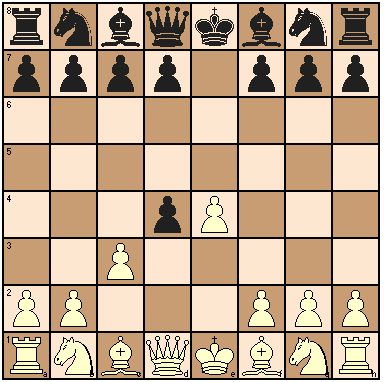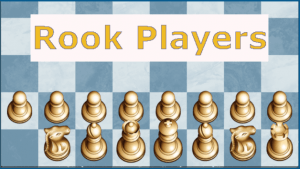
The Northern Gambit
The Northern Gambit

The moves of the Danish or Northern Gambit are 1. e4 e5 2. d4 exd4 3. c3 -
after which Black can accept the gambit with 3...dxc3 or decline it in a variety of ways.

As the 19th century moved into its second half, players in the Scandinavian countries of Denmark and Sweden began playing an opening that would later be dubbed the Danish Gambit.
The name presumably derived from the opening employed by the Danish player, Martin Severin Janus From (1828-1895), in the 1867 Paris international (the first international tournament in which any Dane ever participated) against Winawer, Rosenthal, Golmayo and Czarnowski (this last player lost the only game with this opening), all of whom declined the gambit.
Severin From was an exceptionally bright student but left the university before earning his degree due to conflicts with his instructors. Instead, he joined the Danish army in the 6th brigade and ended up fighting in the July 6, 1849 Battle of Fredricia in which the Danish soldiers drove out the Schleswig-Holstein forces who had seiged the town for almost a month. The Germans had contructed four redoubts. From's brigade stormed and won the Treldeskansen, the strongest of the four ["BCM," July, 1895]. Although he started his working life in the Bureau of Statistics in Copenhagen, Severin From spent most of his life as an assistant prison warden. In 1890 he became the head warden of the Christianshavn Women's Penitentiary. He met Magnus Oscar Møllerstrøm (1824-1864), an auditor for the Bureau of Statistics and the best chess player in Denmark in the 1850s while From was working at the same place in the early 1850s. Møllerstrøm taught From (along with Govert Nielsen) to play chess. From, Nielsen (1830-1913) and Balduin Sørensen (1832-1888) founded the Copenhagen Chess Club - Københavns Skakforenin- in 1865. From won the tournament at Copenhagen in 1862 during which he played black against Dr. Hans Anton Westesson Lindehn, a Swedish player from nearby Gothenburg in a Danish Gambit declined which black won. This was the earliest involvement of Severin From with the Danish Gambit that I could find.
The actual inventor of this opening may not be known, but Dr. H. A. W. Lindehn appears to be the earliest serious practioner. Since Sweden can be considered the cradle of this opening, the Danish Gambit is also called the Northern Gambit. In fact, the "Chess Players' Chronicle" in 1871 wrote:
"We complete the first part of our subject (the Danish Gambit) by reprinting two dashing little games of the celebrated Swedish player, Dr. Lindehn. We may observe that the Swedes claim for their own country the honour of originating this variation. The "Schachzeitung," while favouring the Danish claim to priority, proposes the title of “Northern Centre Gambit,” by way of compromise."
Dr. Lindehn's favortie line: 1. e4 e5 2. d4 exd4 3. c3 dxc3 4. Bc4 has even been called the Lindehn Gambit.
Curiously, not a lot is known about H. A. W. Lindehn and even some of that has been misrepresented. One of the more interesting facts is that Lindehn, who was born in February 1826, died the very same day as did Paul Morphy, July 10, 1884. Many places refer to him as a university professor of philosphy. Lindehn received his Swedish magister degree (filosofie magister) in 1853. This degree was the equivalent of a Ph.D today and allowed him to use the title Dr. before his name. It's unclear what his specialty was, but he took a position as director of F.M. Leffler's lyceum in Gothenburg in October 1865. During the period between 1861-5, he traveled to Paris, London, Belgium and Germany to play chess. Living in both Upsala and Gothenburg (and belonging to the Stockholm Chess Club), Lindehn was usually a reasonable distance from Copenhagen where he possibly met v.d. Lasa who, in turn, did the first published analysis of the Danish Gambit.
Again, in an 1867 "The Chess Player" reprint of Lasa's article in the "Schachzeitung," Lasa wrote:
About eight years ago the Schachzeitung gave examples of a peculiar Gambit, which, after ...
1. P. to K. fourth 1. P. to K. fourth
2. P. to Q. fourth 2. P. takes P. was continued with
3. P. to Q. B. third 3. Q. P. takes P.
4. K. B. to B. fourth,
a line of play recommended by an excellent Swedish player, Lindehn. The attack was then deemed unfavourable for the first player, and it seemed that, as a consequence, it would be altogether abandoned. During my present sojourn, however, in Denmark, the opportunity has been offered me of noticing that this Gambit is frequently adopted here. I consider that it deserves more attention from Chess players than it has hitherto received. The opening seems overbold for White at first sight, but a closer examination will show that in many variations, which at the first glance appear to be quite safe, the second player would soon involve his game in positions quite untenable.
Previous to submitting the opening to a close theoretical scrutiny, it would be desirable to test it more frequently in practice over the board, so that the best lines of play may be established. In order, however, to guide our readers in this debut with our own suggestions, I beg leave to offer here a few remarks, and also present three games in which Mr. From, President of the Copenhagen Chess Club, conducted the attack with great ability.
Only a few notices of this opening, so far as I am aware, have appeared in print, as for example, in the Scliachzeitung of 1854, page 194; 1856, page 306; 1858, pages 423 and 459; 1859, pages 167 and 341 to 347. From these data the Handbuch cursorily alluded to the debut at its 270th page; but it is also necessary to mention that in the Schachseitung of 1849, page 143, a correspondence game between Mr. Kinblad, of Stockholm, and Mr. Swanberg, of Upsala, was published, the former, who had the attack, playing—
1. P. to K. fourth 1. P, to K. fourth
2. P. to Q. fourth 2. P. takes P
3. P. to Q. B. third.
The last move, however, turned out to have been made by mistake and the move intended was K. B. to B. fourth. As the subsequent moves deviated from the Gambit referred to above, I need no longer allude to it.

In 1876, however, Lindehn moved to Philadelphia just in time for the centennial celebrations. In fact, although he later gained U.S. citizenship, he was the official Swedish commissioner for the International Exhibition in Philadelphia and even earned a medal for his exhibition-related publication, "Illustrated Hand-Bok till Philadelphia och dess Omgifningar, Sarskildt for dem som Besoka Verlusutstallpingen 1876"
It's also not quite clear how Lindehn supported himself in the United States. He did some work as a Swedish newspaper correspondent and had some literary endeavors. He supplied a quite detailed biographical introdution for "Roman Days, from the Swedish of V. Rydberg," in 1879. The book is a charming translation of Dr. Viktor Rydberg's writing about the ancient Romans. Lindehn's biography of Rydberg and appraisal of his writings is very complete.

Apparently Lindehn also dabbled in sales to support himself. In 1878, Lindehn obtained rights to translate Clara Jessup Moore's "On Dangerous Ground" into Swedish. By this time the book had gone through four editions and was published in three languages. Swedish would be the fourth.
Lindehn played chess in Philadelphia, New York and Chicago. His oppoenents included some of the best American players. Chessgames.com has 11 of his games. I've found a little more than two dozen other games, but due to size restrictions, I'll only include a sampling here - right below Willard Fiske's article on Chess in Sweden from "Chess Monthly" (1859) and give the rest in Part II.
The existing Stockholm Chess Club was formed August 11th, 1849, and published its Stadgar or Constitution, in pamphlet form, the same year. Its meetings have been held in different localities—at one time at a room in the Exchange,—but it now assembles in Lagergren’s Coffee-house in the Royal Theatre on Jakob’s Square. Its strongest players are Mr. Berg, Mr. I. J. Elfving, a teacher of the modern languages at one of the leading schools of the capital, Mr. H. A. Lindehn, a resident of Upsala, Mr. Levertin, Mr. Nachman, and Captain Sibell.... It is probable that the residence of Von der Lasa as Secretary of the Prussian Legation at Stockholm, may have given an impulse to the practice of chess, and have led either directly or indirectly to the establishmect of the Club. Besides the Club-rooms there are one or two other localities in the capital where chess is played. In the smoking-room of Lacroix’ Restaurant, which is situated in what is known as the Bazaar on the North Bridge, in the heart of the city, a few players may be encountered at almost any hour in the afternoon. From Upsala, which is fifty miles north of Stockholm, and which hears about the same relation to the rest of the kingdom that Oxford does to England, we have received some chess items worthy of publication. There is no organized club, but measures will be soon taken to form one. As we have said above, Mr. H. A. Lindehn, one of the foremost members of the Stockholm Club, resides here. Another good player is Mr. A. Löfwen. The late A. F. Svanberg, Professor of Physics at the University of Upsala, was one of the most enthusiastic and learned chess students of the North. He occupied himself with the study of theoretical chess, of problems and of the Knight’s Tour, and was, morever, a strong practitioner. Whenever he went to Stockholm he was sure to visit the chess circles of the metropolis. He died in 1857. The "Schachzeitung" has published some of his problems and has largely noticed his researches into the Knight’s Tour. One of the most ardent and most widely known of the chess lovers of Sweden is Mr. Jonas Gustav Schultz, now a student of Upsala University. He was born in the province of Smäland, February 23d, 1839, became acquainted with the royal game in 1856, and entered the University in 1857. During the past year he has made himself a name by the publication of many beautiful problems in the Schachzeilung, and elsewhere, and has commenced a regular chess column in an illustrated paper in Stockholm. He is now engaged in the preparation of a Swedish handbook of the game. Such a book is greatly needed, for the only work of any authority in the language is a translation of Lewis’ "Chess for Beginners," which was published a little time since in Stockholm, under the title of "Schack för Begyunare."
The first game is probably the most publicized. It was a lovely miniature against Ladislas Maczuski that highlighted some of the pitfalls in accepting the gambit. Maczuski, the Polish blindfold player and chess professional "who played four, then six, then in Paris, in 1863, eight games simultaneously. Later, in 1876, in a four-game display at the home of the president of the Ferrara Chess Chess Club in northern Italy, he announced mate in 11 moves against Mazzonali (an annoncement apparently ony surpassed by Blackburne's announced mate in 16)." -Eliot Hearst and John Knott "Blindfold Chess"
The "Schachzeitung" gives two games against this unnamed opponent, played in Upsala in 1858. The interesting part is that the German periodical simply calls it an "Irregular Center Game," indicating that the opening wasn't yet considered standard. Unaccountably, a game between Lindehn and J. L. Elfving, published in the "CPC" (1871), "De Schaakwerld" (1874) and "Nordisk Skaktidende" (1874), said to have been played in 1869, contained the exact same moves.
The next game, a variation from Lindehn's usual treatment, was played in London against journalist, Ernst Falkbeer, the inventor of the counter-gambit that bears his name.
Dr. Lindehn played the followed Rook-odds game against an unknown opponent at the Café de la Régence in 1865
In New York, Lindehn played against opponents of high caliber such as Capt. Mackenzie and Eugene Delmar with mediocre results.
In Philadelphia Lindehn crossed swords with Henry E. Bird, whom he had also played in London, and most frequently with Jacob Elson, a rather prolific chess problemist. One of the best Philadelphian players of his day, his games were often published. He lost matches to Gustav Reichhelm +3-5=1 and +5-8; he scored -1+2 against Steinitz but lost to Bird +1-6; he scored +4-4 against the short-lived prodigy, James Leonard.
The Northern Gambit Part II

